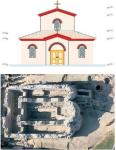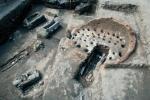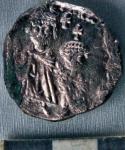Summary (English)
APOLLONIA – SOZOPOLIS (Tsonya Drazheva, Dimitar Nedev – am_sozopol@abv.bg) The three-nave and three-apse basilica to the south of the fortification wall was thoroughly explored. An earlier floor of bricks arranged over a mortar layer was discovered under the floor. Graves from the earlier period of the basilica were explored. Foundations of an earlier single-apse church were discovered under the central nave and the central apse of the basilica. During the second half of the 10th century the basilica was built over the earlier church and it functioned until the 17th century. The walls of the single-apse church were 80 cm wide, built of stones bonded with mortar and preserved up to 1.50 m in height. Graves dated to the end of the 6th – 10th centuries AD were discovered around the church. The grave goods included pottery, coins and belt buckles of the Syracuse Type. The burial pits were either covered with roof-tiles, or surrounded with bricks or small ashlars. A street of the end of the 16th – 17th centuries was discovered, paved with spolia. Strata of the 3rd – 2nd centuries BC, the second half of the 5th century BC and the second half of the 6th century BC were documented. The finds from the Hellenistic period included sherds from apmphorae and apmphora stamps of Sinope, Rhodes and Thasos, Megarian bowls, black-gloss and local pottery. A pottery kiln was explored to the northeast of the apse of the northern nave of the basilica. The finds comprised sherds from amphorae of Chios, Lesbos, Thasos and Miletus, local pottery, black-gloss and black-figure pottery of 550 – 450 BC. A workshop was discovered in front of the altar of the basilica and five metallurgical kilns were explored inside. The finds comprised slag, copper and iron mill-bars, sherds from amphorae, black-figure and East Greek pottery of 540 – 500 BC. A sanctuary with an altar over a platform with stairs was discovered to the northwest of the basilica. The altar was 2.07 m by 1.15 m in size and was preserved up to 1.40 m in height. The finds comprised sherds from amphorae, black-gloss pottery and four amphora stamps of Thasos of the 4th century BC. A public building, 8 m wide and constructed in opus mixtum, was discovered to the west of the basilica. Judging from coins, the building dated to the 5th – 7th centuries AD.
- Tsonya Drazheva - Regional Museum – Burgas
- Dimitar Nedev - Archaeological Museum in Sozopol
Director
Team
Research Body
- Archaeological Museum in Sozopol
- Regional Museum – Burgas






![Download [PDF]](/excavation/skins/fasti/images/results/download_sml.png)

